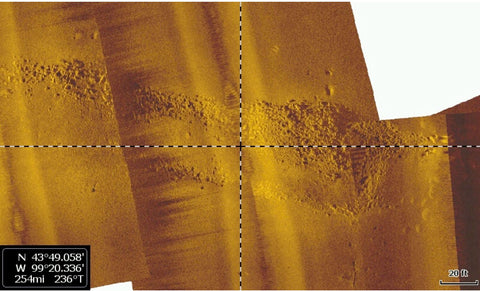Identifying fish size on sonar is very difficult since you can change the size with sensitivity adjustments or depth range. Fish look larger on a depth range of 20 foot than 100 foot. The size of a fish is determined by the color of the fish arch. For example if you have palette colors yellow, blue and red. The more yellow you see the bigger the fish. The thickness of the fish arch also determines fish size. How long the fish arch is just how long the fish is below the transducer.
In the image the black vertical lines show how long the fish is under the transducer and the green lines show the thickness of the fish arch.
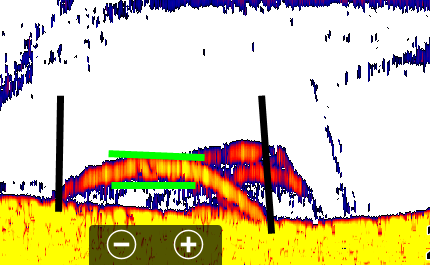
The best way to tell size is catch one the fish you see on sonar or use an Aqua-Vu camera.
The first example shows my bait dropping (green arrow), the bait is intercepted by a bass (red arrow) and the bass swims to the bottom (black arrow) and then I set the hook and catch him.

This is the bass.
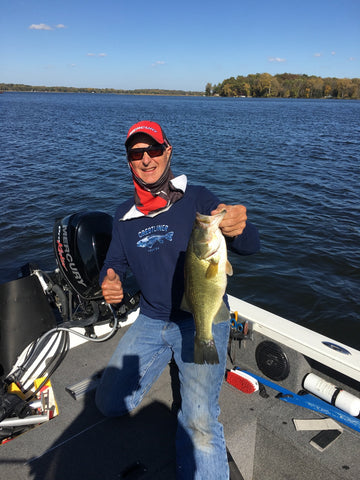
How about these fish. Needless to say I was excited when I found them but they didn't bite so I dropped the Aqua-Vu camera and was surprised what I found.
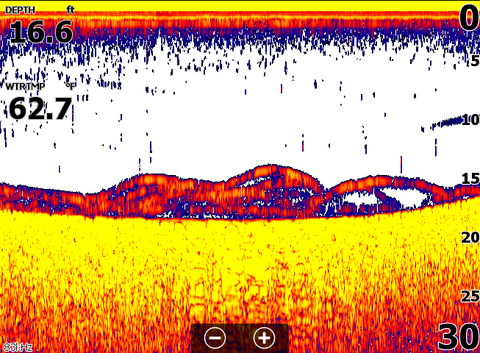

Watch video of fish
On this screenshot is a 7.5 lb. northern pike, you can see when I set the hook and started bringing him to the surface.
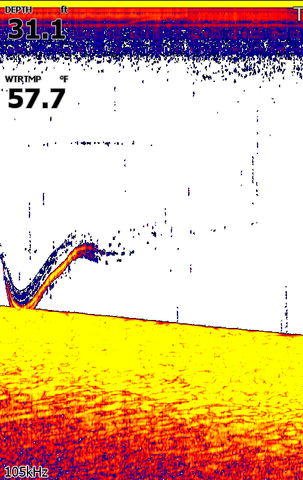
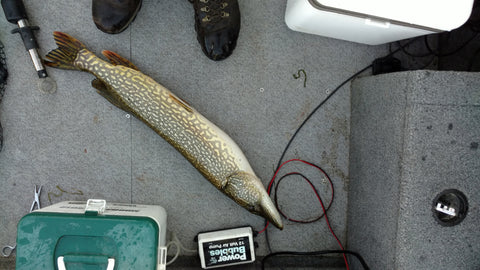
The last screenshot is smallmouth bass and I caught a few, this is a picture of one of them. One of my favorite fish to catch.


This screenshot shows a 29.5 inch walleye after being released.
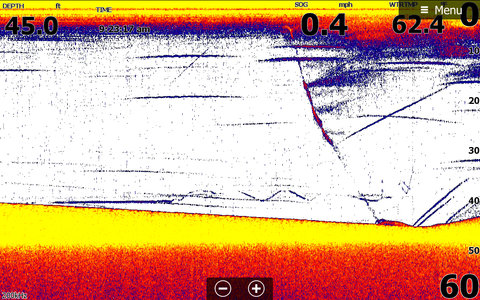

I was lucky in my timing to collect good data to prove fish size on sonar.
Last but not least is what a 5 inch minnow attached to a sinker looks like with 1.5-2.5 lb. walleyes below it.

Learn how crappies display on different sonar brands.
Crappies are a much sought after fish and I get a lot of questions about what they look like on sonar. Crappies often suspend over open water, making them difficult to target. In this session I will show what they look like on different sonar brands.
Image #1 shows crappies on a 2D Garmin sonar using High Chirp.

Image #2 shows the same school with a Humminbird using the MEGA transducer on High Chirp.
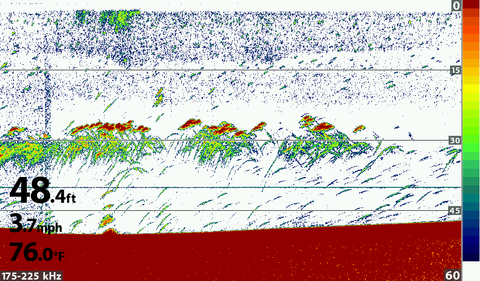
Image #3 is the same school using a Lowrance TM150 transducer set at 105 kHz frequency.
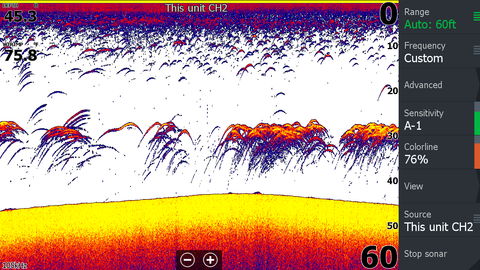
Image #4 shows the same school with the Humminbird side imaging
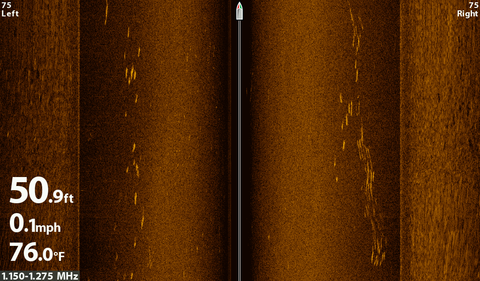
Next are 2 videos showing the Panoptix with 2 different transducers. The PS 30 looks down and to the side and the PS 21 looks to the side.
I use side imaging or the PS 21 to find the school when it moves since they see to the side and I use Minn Kota Spot Lock to sit on the school and vertically jig for supper.
PS 21 video
PS 30 video
GPS Accuracy Posted on August 26, 2017
Ever wonder why your big boulder is in a different place than your waypoint at times? GPS can more accurate one day depending on satellites and weather and where your fish.
The boat is at my dock and I cleared the trail after the GPS locked in really good. This example is normal, I have repeated it many times and this was one of the most accurate examples. I did this one with Lowrance's point 1 GPS.
Your big boulder could move 25 feet on you while you were fishing it!
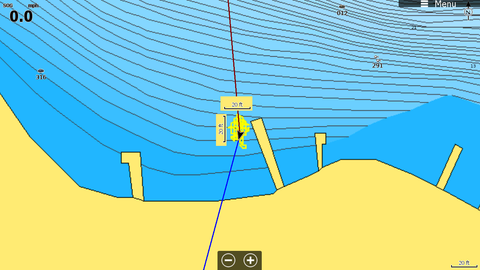
2 short videos
#1 shows bluegills on the Panoptix and explains how the Panoptix works and displays them.
Panoptix video
#2 Aqua-Vu footage of the same bluegills as seen on the Panoptix.
Aqua-Vu video
Drop Shotting with Panoptix Live DownVu
Drop shotting (fishing vertically) is usually done with 2D sonar. This session will explain drop shotting with Panoptix and explain in detail what you are seeing.
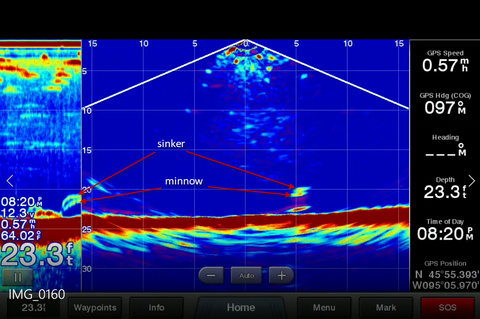
Watch live video
I use sonar to find fish every time I go out but sometimes the fish can hide. Two good examples are boulders and steep drop-offs. The sonar beam is reflected off the bottom on steep drops and off the boulders and the fish can’t be separated.
I drove over this drop-off that had boulders and didn’t see any fish with either the Humminbird or the Lowrance.


I stopped on the edge and used the Spot Lock feature of my Minn Kota trolling motor on the edge and dropped my Aqua-Vu camera down and found these crappies but not just here but each time I moved along the edge there were more crappie.

Watch crappie video here
Even the down imaging couldn’t separate the crappies from the boulders while I was sitting over them.

Notice the crappies are very close to the boulders in the video.
They did bite and they posed for the camera before being released (I had fresh walleye back home).
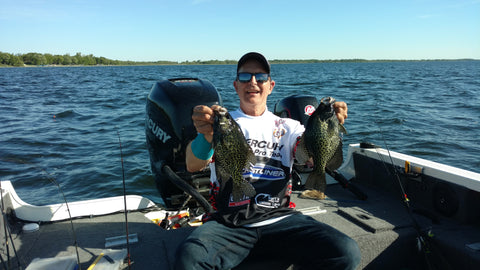
You can make mosaics with Humminbird Helix models using Autochart Pro which is a computer app. You record the sonar data to a blank card and use Autochart Pro to make the mosaic and export it as a mosaic to your Helix. You will use it as the chart with your boat cursor on this map. If you find tech easy this is a good way to use Spot Lock on your favorite reef spot.
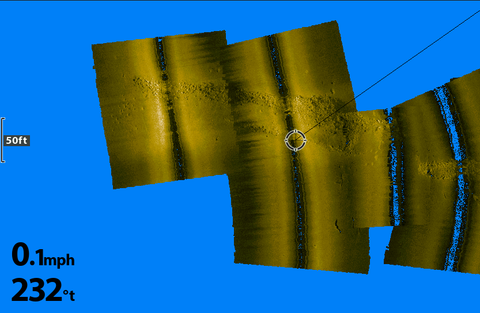
StructureMap is available on the HDS and Carbon but you can share it with the Hook!
If you have logged sonar with a model with side scan you can open it in ReefMaster and export it as map. Think about the value for trolling or anchoring on key structure when the image is your map.
The first image is zoomed out and the 2nd image is zoomed as far as I can with the Hook. Notice the 20 foot scale in the lower right corner for reference.
Since I didn’t have my StructureScan 3d transducer yet I used the Helix Mega to get the side scans. As you can see the MEGA imaging is very crisp.
ReefMaster works with both Lowrance and Humminbird.
If you find tech easy this is a good way to use Spot/Anchor Lock on your favorite reef spot.
Short video on how to use the 3D StructureScan and how to adjust the features and settings.
Watch Video
Author Kirt Hedquist Doctor Sonar Pro Staff
The orange dots are fish, the blue triangle is the area of the water column viewed by the sonar. The brown is the bottom of the lake.
I was mowing the grass doing some scouting you can see some bait fish probably suspended where I started my pass. red circle
To the left of the boat is dropping off to deeper water and shallow to the right (notice how the blue triangle slopes down)
Also note more bait fish just to the right (green circle)

Covering about 360’ in width off to the left and behind the boat you can see a transition to harder bottom as its getting deeper. Red circle
Some fish below and behind the boat the cluster on the left and below maybe some turbulence. Green circle on fish
To the right its getting shallower with a little hump to the right and below the boat. Orange circle

Some fish and baitfish suspended in the water column dropping off to deeper water to the left of the boat. drop-off red circle
The edge of some rocks or rock ridge to the right of the boat. Green circle

Showing some fish and baitfish in the water column deeper to the left getting shallow to the right Red circle on fish, green circle on shallow area

A large amount of bait fish (red circle) and a ridge or rock pile (green circle)
Lots of Smelt in this lake, fish are well fed

More of the same lots bait, a transition from soft to hard with a ridge or rock ridge to the right (red circle)

Shallow water on the left and a drop off to the right


























